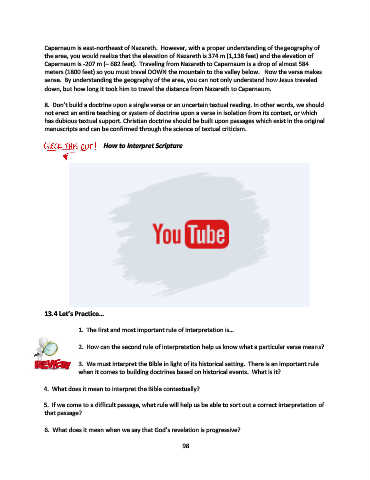Page 99 - Doctrine and History of the Preservation of the Bible Student Textbook
P. 99
Capernaum is east-northeast of Nazareth. However, with a proper understanding of the geography of
the area, you would realize that the elevation of Nazareth is 374 m (1,138 feet) and the elevation of
Capernaum is -207 m (– 682 feet). Traveling from Nazareth to Capernaum is a drop of almost 584
meters (1800 feet) so you must travel DOWN the mountain to the valley below. Now the verse makes
sense. By understanding the geography of the area, you can not only understand how Jesus traveled
down, but how long it took him to travel the distance from Nazareth to Capernaum.
8. Don’t build a doctrine upon a single verse or an uncertain textual reading. In other words, we should
not erect an entire teaching or system of doctrine upon a verse in isolation from its context, or which
has dubious textual support. Christian doctrine should be built upon passages which exist in the original
manuscripts and can be confirmed through the science of textual criticism.
How to Interpret Scripture
13.4 Let’s Practice…
1. The first and most important rule of interpretation is…
2. How can the second rule of interpretation help us know what a particular verse means?
3. We must interpret the Bible in light of its historical setting. There is an important rule
when it comes to building doctrines based on historical events. What is it?
4. What does it mean to interpret the Bible contextually?
5. If we come to a difficult passage, what rule will help us be able to sort out a correct interpretation of
that passage?
6. What does it mean when we say that God’s revelation is progressive?
98

